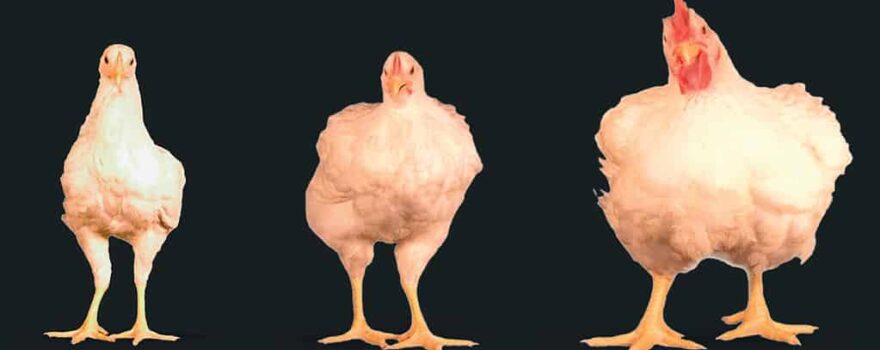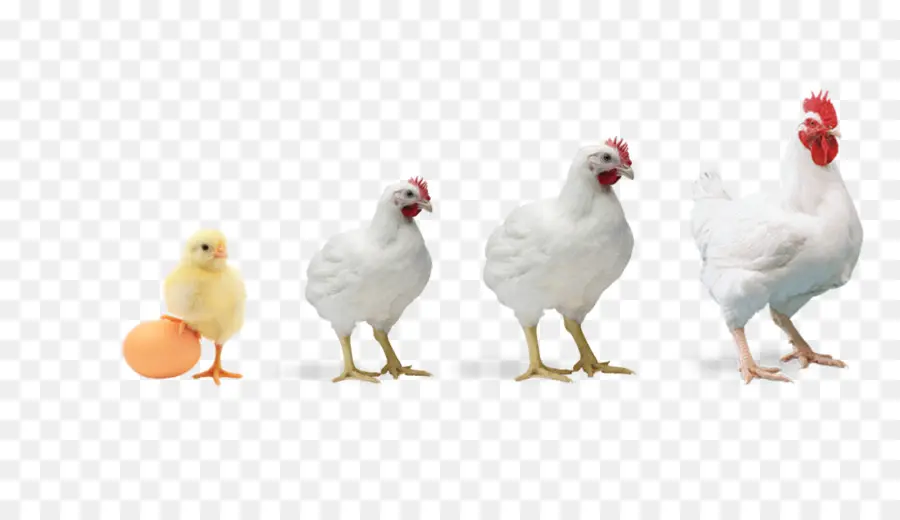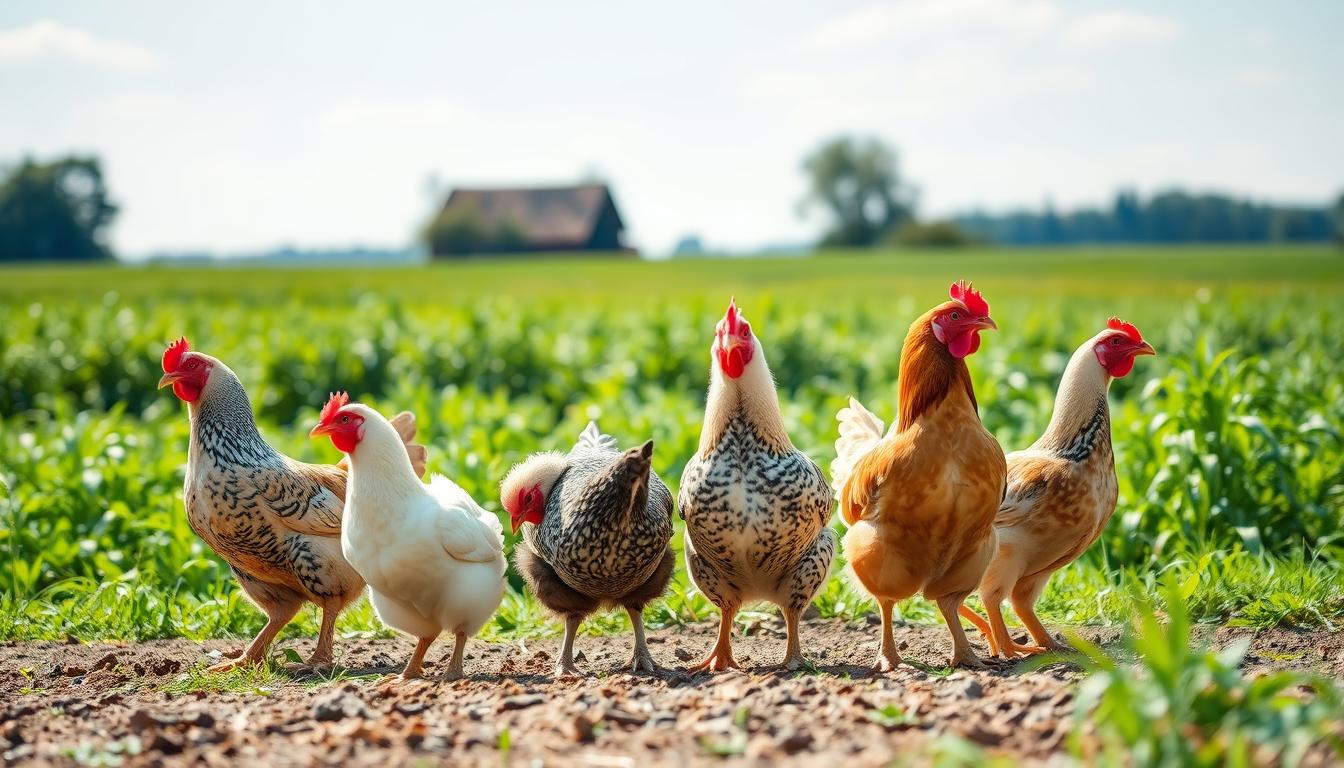
The modern broiler chicken has changed a lot since its wild ancestor, the red jungle fowl (Gallus gallus). Studies show how much these chickens have changed because of humans’ selective breeding. Today’s broiler chickens grow much faster than their wild ancestors.
More people are eating chicken than ever before. It’s now almost as popular as pork. This is because of growing demand in countries where people are getting richer. The number of broiler chickens raised for meat has skyrocketed, with over 65.8 billion eaten in 2016.
Key Takeaways
- Broiler chickens have evolved significantly from their wild progenitor, the red jungle fowl, due to selective breeding.
- Domestic broilers now grow at a rate three times faster than their wild ancestors.
- Chicken meat consumption is growing rapidly, overtaking other meats like pork in many regions.
- The broiler chicken industry has become a massive global enterprise, with over 65.8 billion carcasses consumed annually.
- Advancements in poultry genetics and breeding have transformed the broiler chicken into a highly efficient meat-producing animal.
Ancestors of Modern Broiler Chickens
The domestic chicken, the base of today’s broiler industry, comes from the red jungle fowl. Genome studies show the red jungle fowl is the wild chicken’s ancestor. Archaeologists believe chickens were first tamed by humans about 8,000 years ago in Southeast Asia and Oceania.
Domesticating chickens was quick and spread far, as they offered meat and eggs without taking food from humans. This early taming led to the creation of modern broiler chickens. These birds have changed a lot from their wild ancestors through selective breeding.
Red Jungle Fowl Origins
The red jungle fowl, known as Gallus gallus, is the main wild ancestor of the domestic chicken. They live in the tropical forests of Southeast Asia, like India, China, and the Malay Archipelago. The red jungle fowl’s genome was mapped in 2004, giving us key insights into the chicken’s genetic roots.
| Breed | Origin | Characteristics |
|---|---|---|
| Auracana | Auracania region of Chile | Subject of confusion regarding its origin, with some proposing a Polynesian connection |
| Sebright Bantam | Developed by Sir John Sebright in the early 19th century | Miniature chicken breed |
The genetic changes in modern chickens show how important they are in animal breeding. They also help in biomedical research, showing genes linked to changes in traits.
Selective Breeding Alters Chicken Genetics
The genetics of modern broiler chickens have changed a lot from their wild ancestors. This is mainly because of selective breeding. By the sixteenth century, selective breeding was already changing chicken bones. Today, broiler chickens have a wider body and lower center of gravity, with many bone issues.
Just three major companies have cut the genetic diversity of broiler chickens by 50% or more. This is because of selective breeding programs focused on growth rate and meat yield.
The chicken genome evolution has been greatly influenced by selective breeding. Studies show that modern broiler chickens grow 300% faster than their ancestors in 60 years. This fast growth has led to more musculoskeletal problems, affecting about 28% of the birds.
The genetic diversity reduction in broiler chickens has caused health and welfare issues. The birds struggle with their fast growth and development. This shows we need to balance breeding for production with animal well-being.
| Trait | Wild Red Jungle Fowl | Modern Broiler Chicken |
|---|---|---|
| Eggs Laid per Year | 4-6 | Over 300 |
| Growth Rate | Slower | 300% Increase in 60 Years |
| Musculoskeletal Abnormalities | Lower | Affect 28% of Population |
| Genetic Diversity | Higher | Reduced by 50% or More |
The selective breeding that changed the broiler chicken industry has a cost. It has reduced genetic diversity and harmed the birds’ health. As we learn more about chicken genome evolution, we must balance productivity with animal welfare. This is key for a sustainable poultry industry future.
Rapid Growth and Development
The modern broiler chicken has changed a lot. It grows much faster than its wild ancestors. The Red Jungle Fowl, the chicken’s ancestor, takes 10-30 years to grow up. But today’s broiler chickens can be ready for slaughter in just 5-7 weeks.
This fast growth is thanks to many years of selective breeding. Broiler chickens now grow three times faster than their wild relatives. But this fast growth has a downside. It leads to health problems like skeletal and organ issues. These problems shorten their lives.
Accelerated Growth Rates
The change in broiler chickens is amazing. In the last century, they have grown much faster. Now, Cornish Cross broilers can be ready for slaughter in just 42 days.
This fast growth shows the power of selective breeding. But it also brings health problems for these birds.
| Trait | Red Jungle Fowl | Modern Broiler |
|---|---|---|
| Lifespan | 10-30 years | 5-7 weeks to slaughter |
| Body Weight | 2-3 lbs | 5-8 lbs |
| Egg Production | 10-15 eggs/year | 250-300 eggs/year |

The genetic changes for this fast growth came from targeted breeding. This breeding used the short generation interval and high heritability of key traits. But these birds face health challenges like skeletal and organ problems. These problems can shorten their lives.
The Evolution of Broiler Chickens: From Wild Fowl to Modern Poultry
The modern broiler chicken has a long history. It started with the wild red jungle fowl of Southeast Asia. Over time, chickens evolved from wild birds to a key part of the global poultry industry.
Chickens were first domesticated around 2000 B.C. in the Indus valley. They were used for cockfighting and rituals at first. Later, they became a reliable source of meat and eggs.
Many chicken breeds have been developed over the years. The American Poultry Association, started in 1873, helped classify these breeds. This shows how adaptable chickens are.
The journey from wild fowl to modern poultry is amazing. Today, the poultry industry is very advanced. It produces meat and eggs efficiently. Chickens are now a popular meat worldwide, showing their lasting appeal.
| Key Milestones in the Evolution of Broiler Chickens | Timeline |
|---|---|
| Domestication of chickens in the Indus valley | Around 2000 B.C. |
| Emergence of domestic chickens in Southeast Asia | Around 7500 BCE |
| Chickens spread to other parts of the world | Around 600 BCE |
| Chickens were highly valued in ancient Egypt for religious rituals | Around 500 BCE |
| Chickens were introduced to the Americas by European explorers | 1400s |
| Industrialization of chicken farming | 1800s |
| Development of various chicken breeds through selective breeding | Throughout the 20th century |
The evolution of broiler chickens is incredible. From wildfowl to modern poultry, they have adapted greatly. Through breeding and technology, chickens are now a key food source globally.
Short Lifespan and High Productivity
The modern broiler chicken is a result of selective breeding. It has a very short life compared to its ancestor, the red jungle fowl. These birds are killed between 5-7 weeks old, bred for maximum meat production.
Broiler chickens grow fast due to genetic changes. But, they often have health problems. Their broiler chicken lifespan is much shorter than their wild relatives, who can live up to 11 years.
Despite their short lives, broiler chickens are very productive. They are the most common bird in the world, with over 22.7 billion. Chicken meat is becoming more popular, especially in developing countries.
This change from wild jungle fowl to broiler chickens shows our ability to shape nature. But, we should think about the ethical and environmental costs. As we focus on poultry productivity, we need to consider the bigger picture.
Specialized Breeding Programs
The modern broiler chicken is a key player in the poultry world. It’s the result of focused breeding to grow faster, eat less, and produce more meat. Genetic studies show how breeding has changed these birds’ bodies and behaviors.
Commercial Broiler Strains
Three big companies provide most of the broiler chicks globally. This shows how specialized the industry is. Breeding has cut the genetic variety of these chickens by half or more.
Today’s broiler chickens grow fast, eat less, and have more meat than their wild ancestors. For instance, their growth rate has jumped by over 400% since 1957. But, they face health issues like heart problems and fluid buildup.
In Europe, people ate about 24.2 kg of poultry meat per year from 2019 to 2021. In the US, it was 49.4 kg. This shows how much the world wants efficient broiler chickens.
“Antibiotic use in Dutch farms using fast-growing broiler breeds was 9 times higher than in farms with slower-growing breeds in 2022.”
The breeding programs have made broiler chickens efficient and in demand. But, the long-term effects and ethics of these practices are still debated.
Dietary Changes for Broiler Chickens
Broiler chickens, the modern breed raised for meat, have changed a lot from their wild ancestors. Today, their diet focuses on feed efficiency and cutting feed costs.
A typical broiler chicken diet is mostly cereal grains like corn, wheat, and barley. They also get fishmeal and waste from hatcheries and broilers. This change from a natural diet to grains is to make them more efficient and cost-effective.
Chickens are already very efficient at using feed, with a ratio of 1.8-2. But the large scale of broiler production means a lot of feed and energy are used. This has raised concerns about the environment and ethics of raising broiler chickens.
| Feed Ingredient | Broiler Chickens | Egg-Laying Hens |
|---|---|---|
| Corn | 42.8% | 53% |
| Soybeans | 26.4% | 30% |
| Bakery Meal | 14% | N/A |
The table shows how broiler chickens and egg-laying hens differ in their diets. Broiler chickens rely more on grains and byproducts to be more efficient. This can affect their nutrition and the environment of commercial poultry farming.
Environmental Impact of Broiler Production
The fast growth of broiler chickens has big environmental effects. These effects go beyond the farm, touching on resource use and emissions in the whole supply chain.
Resource Consumption and Emissions
The land needed and nitrogen emissions from broiler feed are more than double those of crops like rice, wheat, and potatoes. This shows the big environmental cost of raising meat on a large scale.
Broiler chickens are the most common birds, with 22.7 billion of them. This huge number shows how much the Earth has changed because of human actions, like raising meat on a big scale.
| Environmental Impact | Broiler Production | Plant-based Crops |
|---|---|---|
| Land Area Required | More than twice as high | Less |
| Nitrogen Emissions | More than twice as high | Less |
The total weight of humans and their animals, like broiler chickens, is now more than all wild animals. This big change shows the big environmental effect of raising broiler chickens today.
“The massive scale of modern broiler production has significant environmental impacts.”
Ethical Considerations
Chickens have changed a lot, from wild birds to fast-growing meat birds. This change raises big ethical questions. Broiler chickens are kept in tight spaces, kill young, and face health problems because they grow fast. Animal lovers say this is wrong and we need to think about how we treat these smart, sentient animals.
Broiler chickens are everywhere, making their situation a big ethical issue. Countries like Switzerland and Sweden have laws to protect these birds. But finding a balance between animal care and human needs is hard for farmers, as studies show.
“Farmers have concerns about the ethical treatment of animals in agriculture, but they also rely on them for economic purposes,” notes a study by Kudo and Macer (1999).
The way we treat broiler chickens is a big deal in politics. Over 9 billion chickens are killed in the U.S. every year. Changing to slower-growing breeds or better farming methods could help. But it would mean big changes for the industry.
As we think more about the ethics of raising broiler chickens, we need to look closely at animal welfare, human needs, and money. This is important for making better choices.

Future Developments in Broiler Production
The poultry industry is always changing. Researchers are looking into new ways to make broiler chicken production better. They’re exploring the use of insect-based feed, which is more sustainable and rich in protein.
This move towards alternative proteins is driven by the need to reduce the environmental impact of traditional farming. The current methods are costly to the environment, using more resources and emitting more than many plant-based options.
As people become more concerned about sustainability and animal welfare, the industry might change. It could move towards less intense farming and rethink its role in our diet. This could lead to new ways of producing chicken that are better for animals, use fewer resources, and meet global protein needs.
The future of broiler production will depend on tech progress, changing consumer tastes, and a focus on sustainability and ethics. By tackling the environmental and ethical issues of today’s broiler model, the poultry industry can create a more sustainable and responsible future.